Business Ethics, Environmental Sustainability, and Governance Essay
VerifiedAdded on 2022/09/09
|10
|3482
|19
Essay
AI Summary
This essay, submitted by a student, examines the intersection of business ethics, environmental sustainability, and governance through a case study of S&J, a hard landscaping goods company. The essay analyzes an ethical dilemma involving the use of lower-quality materials and child labor, identifying affected stakeholders such as customers, employees, and suppliers. It evaluates the ethical issues and applies utilitarianism and virtue ethics to the case, offering recommendations from a director's perspective. The essay also explores stakeholder theory, discussing its emergence and the impact of globalization on stakeholders. It highlights the importance of meeting obligations to stakeholders for organizational sustainability and discusses the influence of globalization on various stakeholders. The essay provides a comprehensive overview of ethical decision-making, sustainable business practices, and the role of stakeholders in a globalized business environment.
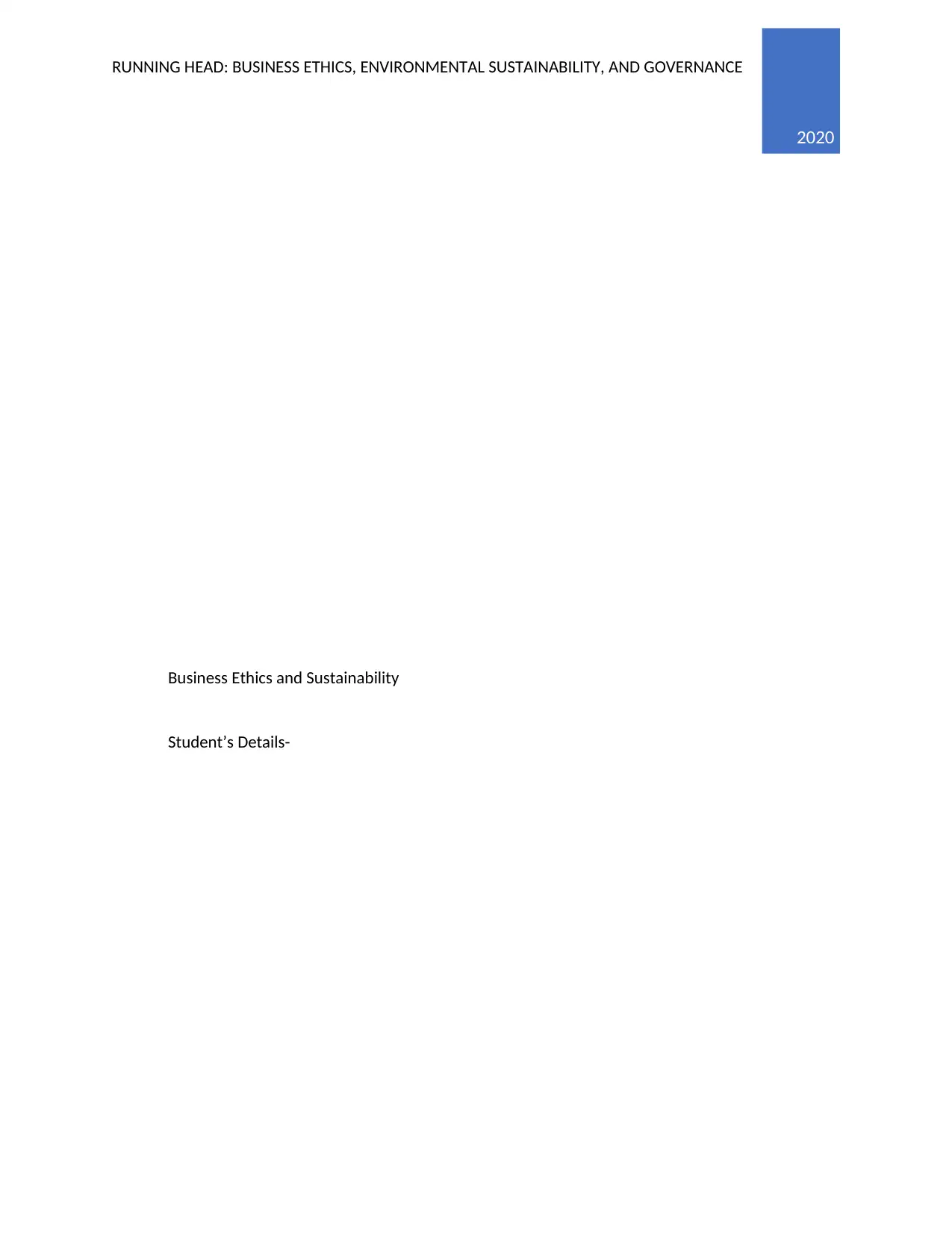
RUNNING HEAD: BUSINESS ETHICS, ENVIRONMENTAL SUSTAINABILITY, AND GOVERNANCE 0
2020
Business Ethics and Sustainability
Student’s Details-
2020
Business Ethics and Sustainability
Student’s Details-
Paraphrase This Document
Need a fresh take? Get an instant paraphrase of this document with our AI Paraphraser
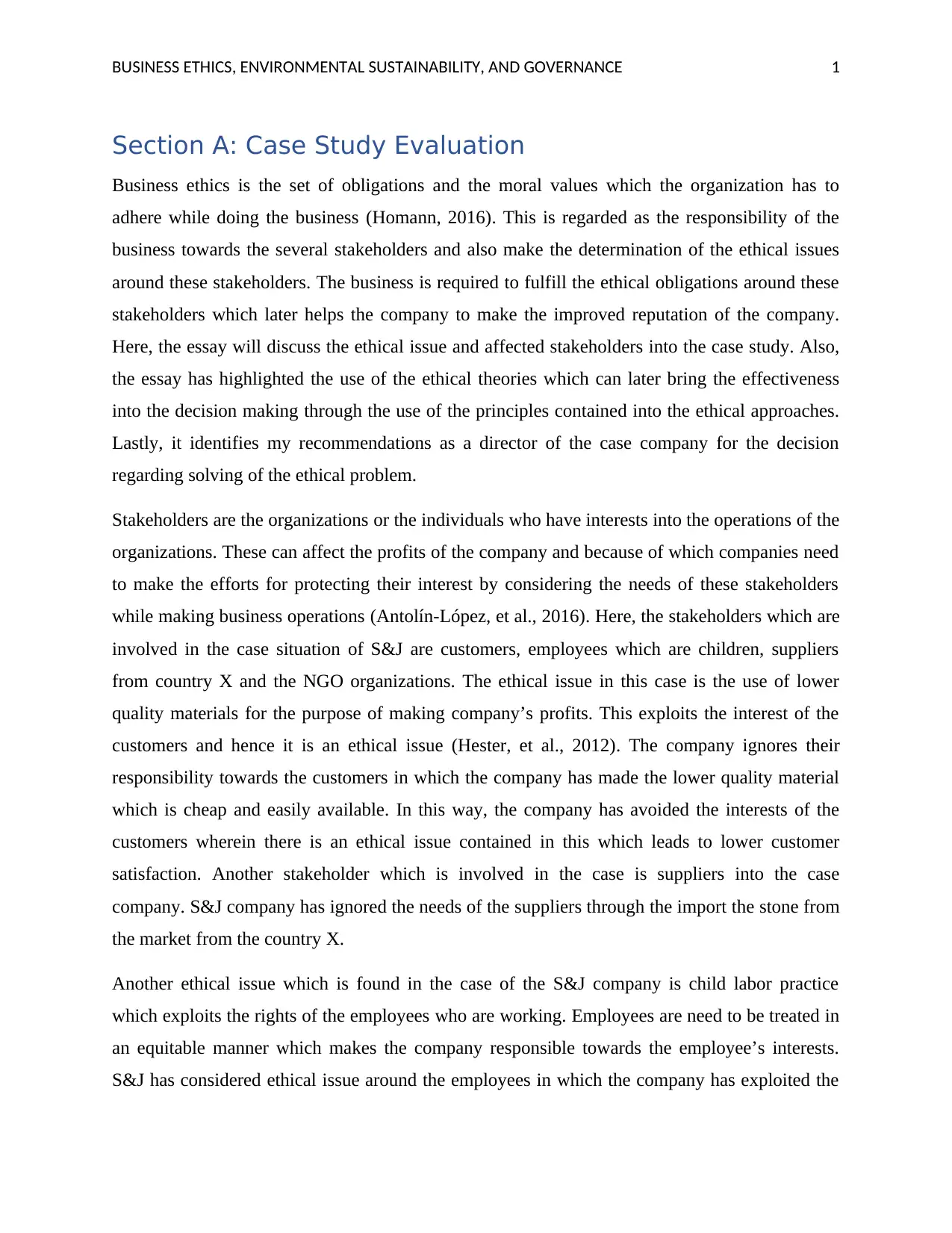
BUSINESS ETHICS, ENVIRONMENTAL SUSTAINABILITY, AND GOVERNANCE 1
Section A: Case Study Evaluation
Business ethics is the set of obligations and the moral values which the organization has to
adhere while doing the business (Homann, 2016). This is regarded as the responsibility of the
business towards the several stakeholders and also make the determination of the ethical issues
around these stakeholders. The business is required to fulfill the ethical obligations around these
stakeholders which later helps the company to make the improved reputation of the company.
Here, the essay will discuss the ethical issue and affected stakeholders into the case study. Also,
the essay has highlighted the use of the ethical theories which can later bring the effectiveness
into the decision making through the use of the principles contained into the ethical approaches.
Lastly, it identifies my recommendations as a director of the case company for the decision
regarding solving of the ethical problem.
Stakeholders are the organizations or the individuals who have interests into the operations of the
organizations. These can affect the profits of the company and because of which companies need
to make the efforts for protecting their interest by considering the needs of these stakeholders
while making business operations (Antolín-López, et al., 2016). Here, the stakeholders which are
involved in the case situation of S&J are customers, employees which are children, suppliers
from country X and the NGO organizations. The ethical issue in this case is the use of lower
quality materials for the purpose of making company’s profits. This exploits the interest of the
customers and hence it is an ethical issue (Hester, et al., 2012). The company ignores their
responsibility towards the customers in which the company has made the lower quality material
which is cheap and easily available. In this way, the company has avoided the interests of the
customers wherein there is an ethical issue contained in this which leads to lower customer
satisfaction. Another stakeholder which is involved in the case is suppliers into the case
company. S&J company has ignored the needs of the suppliers through the import the stone from
the market from the country X.
Another ethical issue which is found in the case of the S&J company is child labor practice
which exploits the rights of the employees who are working. Employees are need to be treated in
an equitable manner which makes the company responsible towards the employee’s interests.
S&J has considered ethical issue around the employees in which the company has exploited the
Section A: Case Study Evaluation
Business ethics is the set of obligations and the moral values which the organization has to
adhere while doing the business (Homann, 2016). This is regarded as the responsibility of the
business towards the several stakeholders and also make the determination of the ethical issues
around these stakeholders. The business is required to fulfill the ethical obligations around these
stakeholders which later helps the company to make the improved reputation of the company.
Here, the essay will discuss the ethical issue and affected stakeholders into the case study. Also,
the essay has highlighted the use of the ethical theories which can later bring the effectiveness
into the decision making through the use of the principles contained into the ethical approaches.
Lastly, it identifies my recommendations as a director of the case company for the decision
regarding solving of the ethical problem.
Stakeholders are the organizations or the individuals who have interests into the operations of the
organizations. These can affect the profits of the company and because of which companies need
to make the efforts for protecting their interest by considering the needs of these stakeholders
while making business operations (Antolín-López, et al., 2016). Here, the stakeholders which are
involved in the case situation of S&J are customers, employees which are children, suppliers
from country X and the NGO organizations. The ethical issue in this case is the use of lower
quality materials for the purpose of making company’s profits. This exploits the interest of the
customers and hence it is an ethical issue (Hester, et al., 2012). The company ignores their
responsibility towards the customers in which the company has made the lower quality material
which is cheap and easily available. In this way, the company has avoided the interests of the
customers wherein there is an ethical issue contained in this which leads to lower customer
satisfaction. Another stakeholder which is involved in the case is suppliers into the case
company. S&J company has ignored the needs of the suppliers through the import the stone from
the market from the country X.
Another ethical issue which is found in the case of the S&J company is child labor practice
which exploits the rights of the employees who are working. Employees are need to be treated in
an equitable manner which makes the company responsible towards the employee’s interests.
S&J has considered ethical issue around the employees in which the company has exploited the
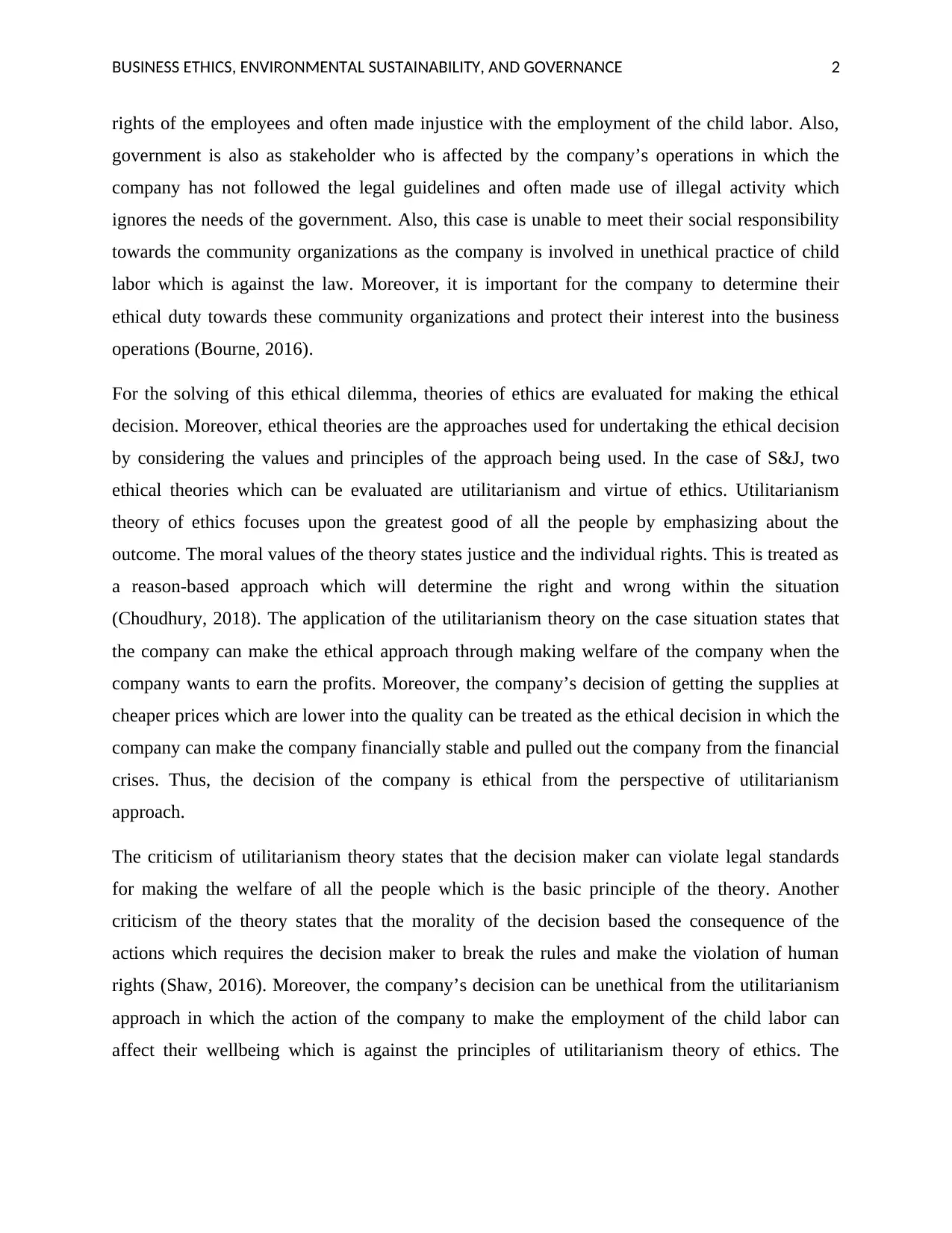
BUSINESS ETHICS, ENVIRONMENTAL SUSTAINABILITY, AND GOVERNANCE 2
rights of the employees and often made injustice with the employment of the child labor. Also,
government is also as stakeholder who is affected by the company’s operations in which the
company has not followed the legal guidelines and often made use of illegal activity which
ignores the needs of the government. Also, this case is unable to meet their social responsibility
towards the community organizations as the company is involved in unethical practice of child
labor which is against the law. Moreover, it is important for the company to determine their
ethical duty towards these community organizations and protect their interest into the business
operations (Bourne, 2016).
For the solving of this ethical dilemma, theories of ethics are evaluated for making the ethical
decision. Moreover, ethical theories are the approaches used for undertaking the ethical decision
by considering the values and principles of the approach being used. In the case of S&J, two
ethical theories which can be evaluated are utilitarianism and virtue of ethics. Utilitarianism
theory of ethics focuses upon the greatest good of all the people by emphasizing about the
outcome. The moral values of the theory states justice and the individual rights. This is treated as
a reason-based approach which will determine the right and wrong within the situation
(Choudhury, 2018). The application of the utilitarianism theory on the case situation states that
the company can make the ethical approach through making welfare of the company when the
company wants to earn the profits. Moreover, the company’s decision of getting the supplies at
cheaper prices which are lower into the quality can be treated as the ethical decision in which the
company can make the company financially stable and pulled out the company from the financial
crises. Thus, the decision of the company is ethical from the perspective of utilitarianism
approach.
The criticism of utilitarianism theory states that the decision maker can violate legal standards
for making the welfare of all the people which is the basic principle of the theory. Another
criticism of the theory states that the morality of the decision based the consequence of the
actions which requires the decision maker to break the rules and make the violation of human
rights (Shaw, 2016). Moreover, the company’s decision can be unethical from the utilitarianism
approach in which the action of the company to make the employment of the child labor can
affect their wellbeing which is against the principles of utilitarianism theory of ethics. The
rights of the employees and often made injustice with the employment of the child labor. Also,
government is also as stakeholder who is affected by the company’s operations in which the
company has not followed the legal guidelines and often made use of illegal activity which
ignores the needs of the government. Also, this case is unable to meet their social responsibility
towards the community organizations as the company is involved in unethical practice of child
labor which is against the law. Moreover, it is important for the company to determine their
ethical duty towards these community organizations and protect their interest into the business
operations (Bourne, 2016).
For the solving of this ethical dilemma, theories of ethics are evaluated for making the ethical
decision. Moreover, ethical theories are the approaches used for undertaking the ethical decision
by considering the values and principles of the approach being used. In the case of S&J, two
ethical theories which can be evaluated are utilitarianism and virtue of ethics. Utilitarianism
theory of ethics focuses upon the greatest good of all the people by emphasizing about the
outcome. The moral values of the theory states justice and the individual rights. This is treated as
a reason-based approach which will determine the right and wrong within the situation
(Choudhury, 2018). The application of the utilitarianism theory on the case situation states that
the company can make the ethical approach through making welfare of the company when the
company wants to earn the profits. Moreover, the company’s decision of getting the supplies at
cheaper prices which are lower into the quality can be treated as the ethical decision in which the
company can make the company financially stable and pulled out the company from the financial
crises. Thus, the decision of the company is ethical from the perspective of utilitarianism
approach.
The criticism of utilitarianism theory states that the decision maker can violate legal standards
for making the welfare of all the people which is the basic principle of the theory. Another
criticism of the theory states that the morality of the decision based the consequence of the
actions which requires the decision maker to break the rules and make the violation of human
rights (Shaw, 2016). Moreover, the company’s decision can be unethical from the utilitarianism
approach in which the action of the company to make the employment of the child labor can
affect their wellbeing which is against the principles of utilitarianism theory of ethics. The
⊘ This is a preview!⊘
Do you want full access?
Subscribe today to unlock all pages.

Trusted by 1+ million students worldwide
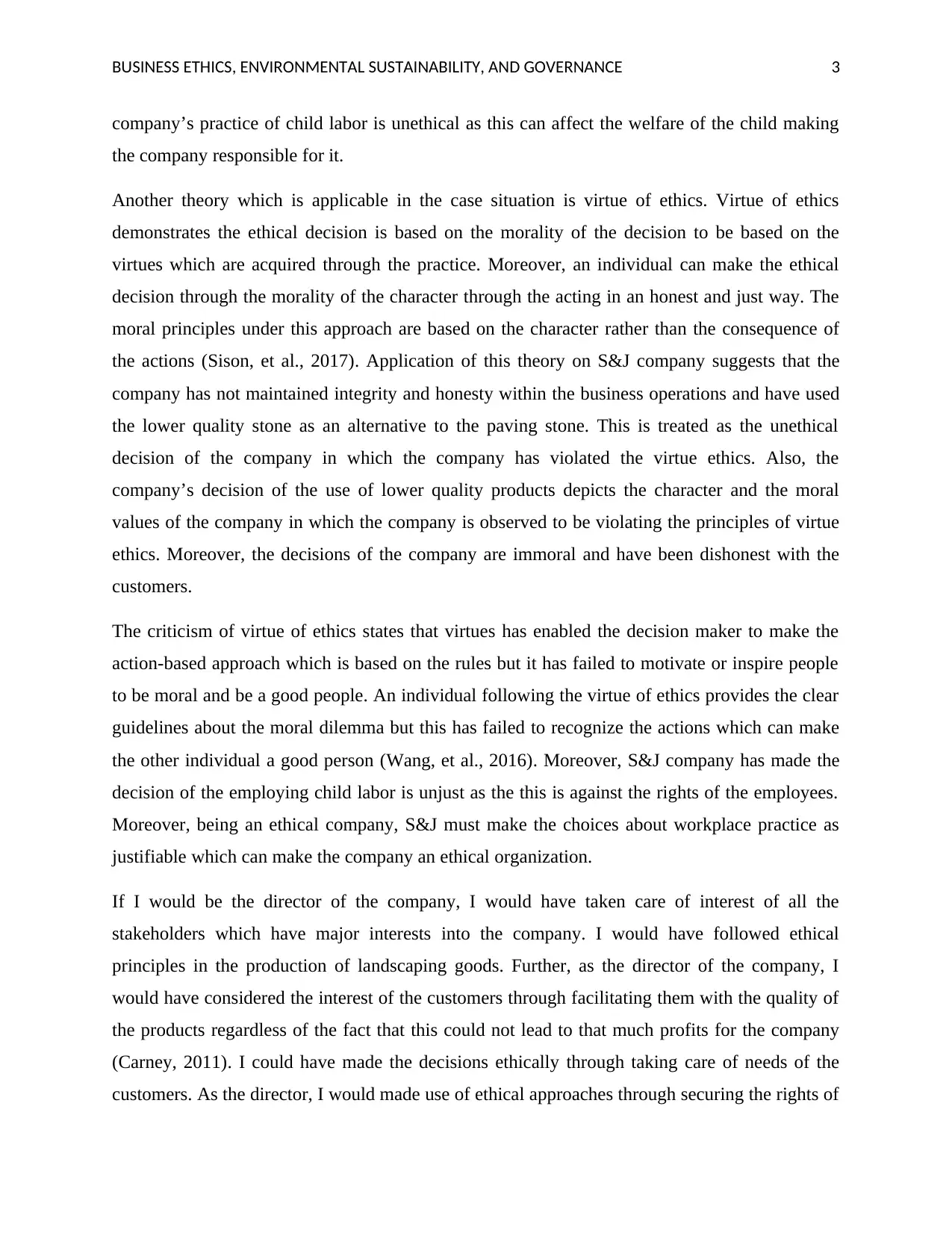
BUSINESS ETHICS, ENVIRONMENTAL SUSTAINABILITY, AND GOVERNANCE 3
company’s practice of child labor is unethical as this can affect the welfare of the child making
the company responsible for it.
Another theory which is applicable in the case situation is virtue of ethics. Virtue of ethics
demonstrates the ethical decision is based on the morality of the decision to be based on the
virtues which are acquired through the practice. Moreover, an individual can make the ethical
decision through the morality of the character through the acting in an honest and just way. The
moral principles under this approach are based on the character rather than the consequence of
the actions (Sison, et al., 2017). Application of this theory on S&J company suggests that the
company has not maintained integrity and honesty within the business operations and have used
the lower quality stone as an alternative to the paving stone. This is treated as the unethical
decision of the company in which the company has violated the virtue ethics. Also, the
company’s decision of the use of lower quality products depicts the character and the moral
values of the company in which the company is observed to be violating the principles of virtue
ethics. Moreover, the decisions of the company are immoral and have been dishonest with the
customers.
The criticism of virtue of ethics states that virtues has enabled the decision maker to make the
action-based approach which is based on the rules but it has failed to motivate or inspire people
to be moral and be a good people. An individual following the virtue of ethics provides the clear
guidelines about the moral dilemma but this has failed to recognize the actions which can make
the other individual a good person (Wang, et al., 2016). Moreover, S&J company has made the
decision of the employing child labor is unjust as the this is against the rights of the employees.
Moreover, being an ethical company, S&J must make the choices about workplace practice as
justifiable which can make the company an ethical organization.
If I would be the director of the company, I would have taken care of interest of all the
stakeholders which have major interests into the company. I would have followed ethical
principles in the production of landscaping goods. Further, as the director of the company, I
would have considered the interest of the customers through facilitating them with the quality of
the products regardless of the fact that this could not lead to that much profits for the company
(Carney, 2011). I could have made the decisions ethically through taking care of needs of the
customers. As the director, I would made use of ethical approaches through securing the rights of
company’s practice of child labor is unethical as this can affect the welfare of the child making
the company responsible for it.
Another theory which is applicable in the case situation is virtue of ethics. Virtue of ethics
demonstrates the ethical decision is based on the morality of the decision to be based on the
virtues which are acquired through the practice. Moreover, an individual can make the ethical
decision through the morality of the character through the acting in an honest and just way. The
moral principles under this approach are based on the character rather than the consequence of
the actions (Sison, et al., 2017). Application of this theory on S&J company suggests that the
company has not maintained integrity and honesty within the business operations and have used
the lower quality stone as an alternative to the paving stone. This is treated as the unethical
decision of the company in which the company has violated the virtue ethics. Also, the
company’s decision of the use of lower quality products depicts the character and the moral
values of the company in which the company is observed to be violating the principles of virtue
ethics. Moreover, the decisions of the company are immoral and have been dishonest with the
customers.
The criticism of virtue of ethics states that virtues has enabled the decision maker to make the
action-based approach which is based on the rules but it has failed to motivate or inspire people
to be moral and be a good people. An individual following the virtue of ethics provides the clear
guidelines about the moral dilemma but this has failed to recognize the actions which can make
the other individual a good person (Wang, et al., 2016). Moreover, S&J company has made the
decision of the employing child labor is unjust as the this is against the rights of the employees.
Moreover, being an ethical company, S&J must make the choices about workplace practice as
justifiable which can make the company an ethical organization.
If I would be the director of the company, I would have taken care of interest of all the
stakeholders which have major interests into the company. I would have followed ethical
principles in the production of landscaping goods. Further, as the director of the company, I
would have considered the interest of the customers through facilitating them with the quality of
the products regardless of the fact that this could not lead to that much profits for the company
(Carney, 2011). I could have made the decisions ethically through taking care of needs of the
customers. As the director, I would made use of ethical approaches through securing the rights of
Paraphrase This Document
Need a fresh take? Get an instant paraphrase of this document with our AI Paraphraser
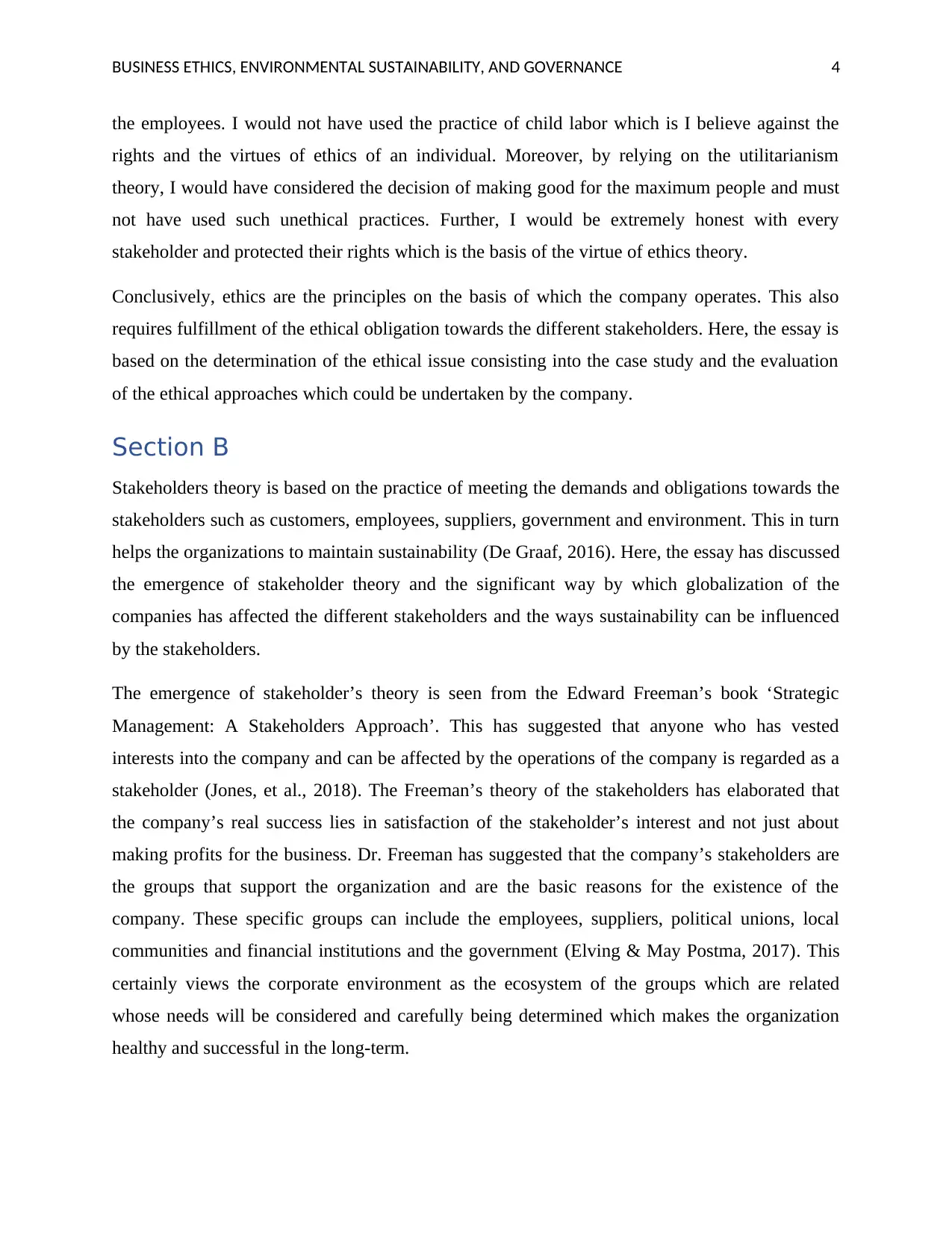
BUSINESS ETHICS, ENVIRONMENTAL SUSTAINABILITY, AND GOVERNANCE 4
the employees. I would not have used the practice of child labor which is I believe against the
rights and the virtues of ethics of an individual. Moreover, by relying on the utilitarianism
theory, I would have considered the decision of making good for the maximum people and must
not have used such unethical practices. Further, I would be extremely honest with every
stakeholder and protected their rights which is the basis of the virtue of ethics theory.
Conclusively, ethics are the principles on the basis of which the company operates. This also
requires fulfillment of the ethical obligation towards the different stakeholders. Here, the essay is
based on the determination of the ethical issue consisting into the case study and the evaluation
of the ethical approaches which could be undertaken by the company.
Section B
Stakeholders theory is based on the practice of meeting the demands and obligations towards the
stakeholders such as customers, employees, suppliers, government and environment. This in turn
helps the organizations to maintain sustainability (De Graaf, 2016). Here, the essay has discussed
the emergence of stakeholder theory and the significant way by which globalization of the
companies has affected the different stakeholders and the ways sustainability can be influenced
by the stakeholders.
The emergence of stakeholder’s theory is seen from the Edward Freeman’s book ‘Strategic
Management: A Stakeholders Approach’. This has suggested that anyone who has vested
interests into the company and can be affected by the operations of the company is regarded as a
stakeholder (Jones, et al., 2018). The Freeman’s theory of the stakeholders has elaborated that
the company’s real success lies in satisfaction of the stakeholder’s interest and not just about
making profits for the business. Dr. Freeman has suggested that the company’s stakeholders are
the groups that support the organization and are the basic reasons for the existence of the
company. These specific groups can include the employees, suppliers, political unions, local
communities and financial institutions and the government (Elving & May Postma, 2017). This
certainly views the corporate environment as the ecosystem of the groups which are related
whose needs will be considered and carefully being determined which makes the organization
healthy and successful in the long-term.
the employees. I would not have used the practice of child labor which is I believe against the
rights and the virtues of ethics of an individual. Moreover, by relying on the utilitarianism
theory, I would have considered the decision of making good for the maximum people and must
not have used such unethical practices. Further, I would be extremely honest with every
stakeholder and protected their rights which is the basis of the virtue of ethics theory.
Conclusively, ethics are the principles on the basis of which the company operates. This also
requires fulfillment of the ethical obligation towards the different stakeholders. Here, the essay is
based on the determination of the ethical issue consisting into the case study and the evaluation
of the ethical approaches which could be undertaken by the company.
Section B
Stakeholders theory is based on the practice of meeting the demands and obligations towards the
stakeholders such as customers, employees, suppliers, government and environment. This in turn
helps the organizations to maintain sustainability (De Graaf, 2016). Here, the essay has discussed
the emergence of stakeholder theory and the significant way by which globalization of the
companies has affected the different stakeholders and the ways sustainability can be influenced
by the stakeholders.
The emergence of stakeholder’s theory is seen from the Edward Freeman’s book ‘Strategic
Management: A Stakeholders Approach’. This has suggested that anyone who has vested
interests into the company and can be affected by the operations of the company is regarded as a
stakeholder (Jones, et al., 2018). The Freeman’s theory of the stakeholders has elaborated that
the company’s real success lies in satisfaction of the stakeholder’s interest and not just about
making profits for the business. Dr. Freeman has suggested that the company’s stakeholders are
the groups that support the organization and are the basic reasons for the existence of the
company. These specific groups can include the employees, suppliers, political unions, local
communities and financial institutions and the government (Elving & May Postma, 2017). This
certainly views the corporate environment as the ecosystem of the groups which are related
whose needs will be considered and carefully being determined which makes the organization
healthy and successful in the long-term.
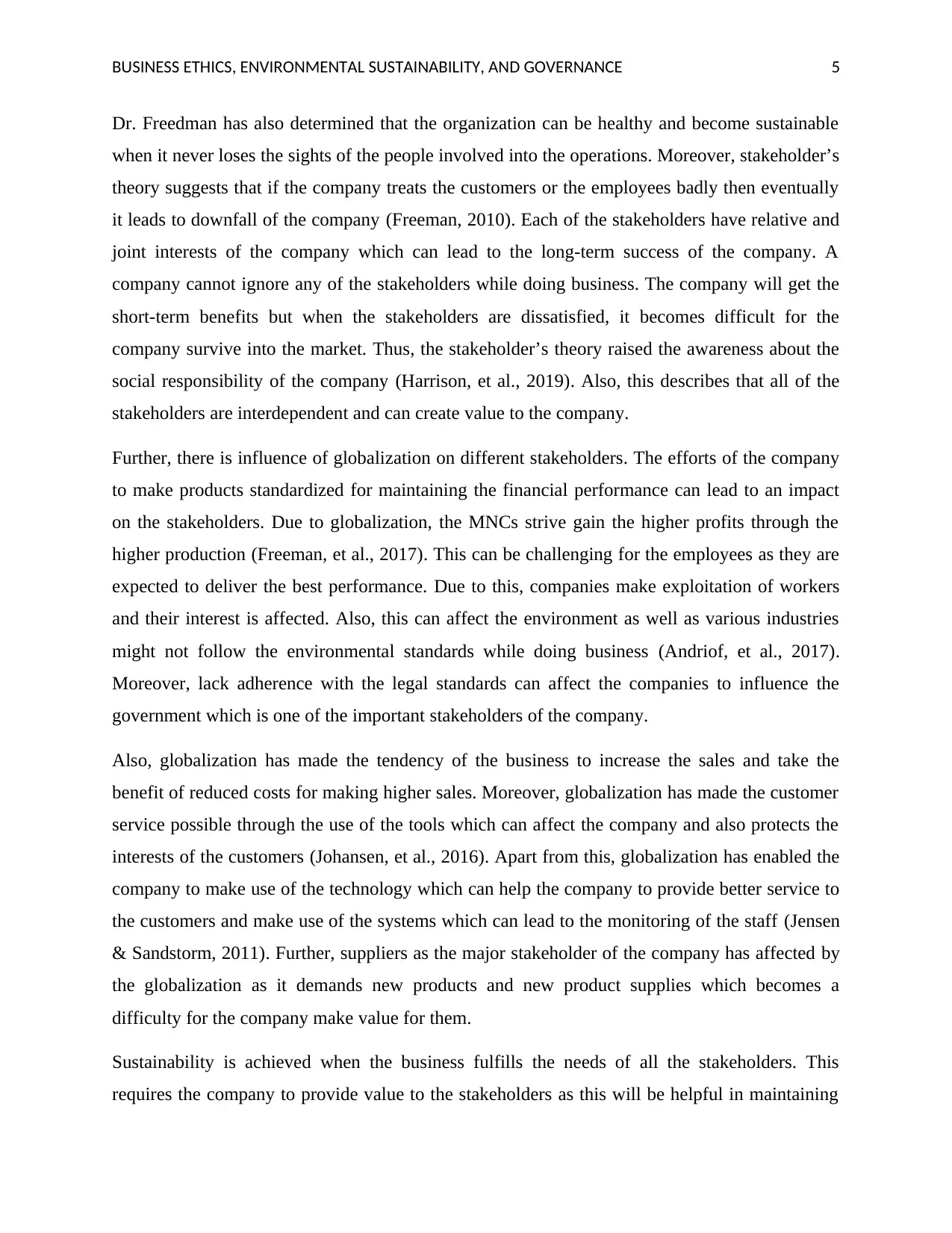
BUSINESS ETHICS, ENVIRONMENTAL SUSTAINABILITY, AND GOVERNANCE 5
Dr. Freedman has also determined that the organization can be healthy and become sustainable
when it never loses the sights of the people involved into the operations. Moreover, stakeholder’s
theory suggests that if the company treats the customers or the employees badly then eventually
it leads to downfall of the company (Freeman, 2010). Each of the stakeholders have relative and
joint interests of the company which can lead to the long-term success of the company. A
company cannot ignore any of the stakeholders while doing business. The company will get the
short-term benefits but when the stakeholders are dissatisfied, it becomes difficult for the
company survive into the market. Thus, the stakeholder’s theory raised the awareness about the
social responsibility of the company (Harrison, et al., 2019). Also, this describes that all of the
stakeholders are interdependent and can create value to the company.
Further, there is influence of globalization on different stakeholders. The efforts of the company
to make products standardized for maintaining the financial performance can lead to an impact
on the stakeholders. Due to globalization, the MNCs strive gain the higher profits through the
higher production (Freeman, et al., 2017). This can be challenging for the employees as they are
expected to deliver the best performance. Due to this, companies make exploitation of workers
and their interest is affected. Also, this can affect the environment as well as various industries
might not follow the environmental standards while doing business (Andriof, et al., 2017).
Moreover, lack adherence with the legal standards can affect the companies to influence the
government which is one of the important stakeholders of the company.
Also, globalization has made the tendency of the business to increase the sales and take the
benefit of reduced costs for making higher sales. Moreover, globalization has made the customer
service possible through the use of the tools which can affect the company and also protects the
interests of the customers (Johansen, et al., 2016). Apart from this, globalization has enabled the
company to make use of the technology which can help the company to provide better service to
the customers and make use of the systems which can lead to the monitoring of the staff (Jensen
& Sandstorm, 2011). Further, suppliers as the major stakeholder of the company has affected by
the globalization as it demands new products and new product supplies which becomes a
difficulty for the company make value for them.
Sustainability is achieved when the business fulfills the needs of all the stakeholders. This
requires the company to provide value to the stakeholders as this will be helpful in maintaining
Dr. Freedman has also determined that the organization can be healthy and become sustainable
when it never loses the sights of the people involved into the operations. Moreover, stakeholder’s
theory suggests that if the company treats the customers or the employees badly then eventually
it leads to downfall of the company (Freeman, 2010). Each of the stakeholders have relative and
joint interests of the company which can lead to the long-term success of the company. A
company cannot ignore any of the stakeholders while doing business. The company will get the
short-term benefits but when the stakeholders are dissatisfied, it becomes difficult for the
company survive into the market. Thus, the stakeholder’s theory raised the awareness about the
social responsibility of the company (Harrison, et al., 2019). Also, this describes that all of the
stakeholders are interdependent and can create value to the company.
Further, there is influence of globalization on different stakeholders. The efforts of the company
to make products standardized for maintaining the financial performance can lead to an impact
on the stakeholders. Due to globalization, the MNCs strive gain the higher profits through the
higher production (Freeman, et al., 2017). This can be challenging for the employees as they are
expected to deliver the best performance. Due to this, companies make exploitation of workers
and their interest is affected. Also, this can affect the environment as well as various industries
might not follow the environmental standards while doing business (Andriof, et al., 2017).
Moreover, lack adherence with the legal standards can affect the companies to influence the
government which is one of the important stakeholders of the company.
Also, globalization has made the tendency of the business to increase the sales and take the
benefit of reduced costs for making higher sales. Moreover, globalization has made the customer
service possible through the use of the tools which can affect the company and also protects the
interests of the customers (Johansen, et al., 2016). Apart from this, globalization has enabled the
company to make use of the technology which can help the company to provide better service to
the customers and make use of the systems which can lead to the monitoring of the staff (Jensen
& Sandstorm, 2011). Further, suppliers as the major stakeholder of the company has affected by
the globalization as it demands new products and new product supplies which becomes a
difficulty for the company make value for them.
Sustainability is achieved when the business fulfills the needs of all the stakeholders. This
requires the company to provide value to the stakeholders as this will be helpful in maintaining
⊘ This is a preview!⊘
Do you want full access?
Subscribe today to unlock all pages.

Trusted by 1+ million students worldwide
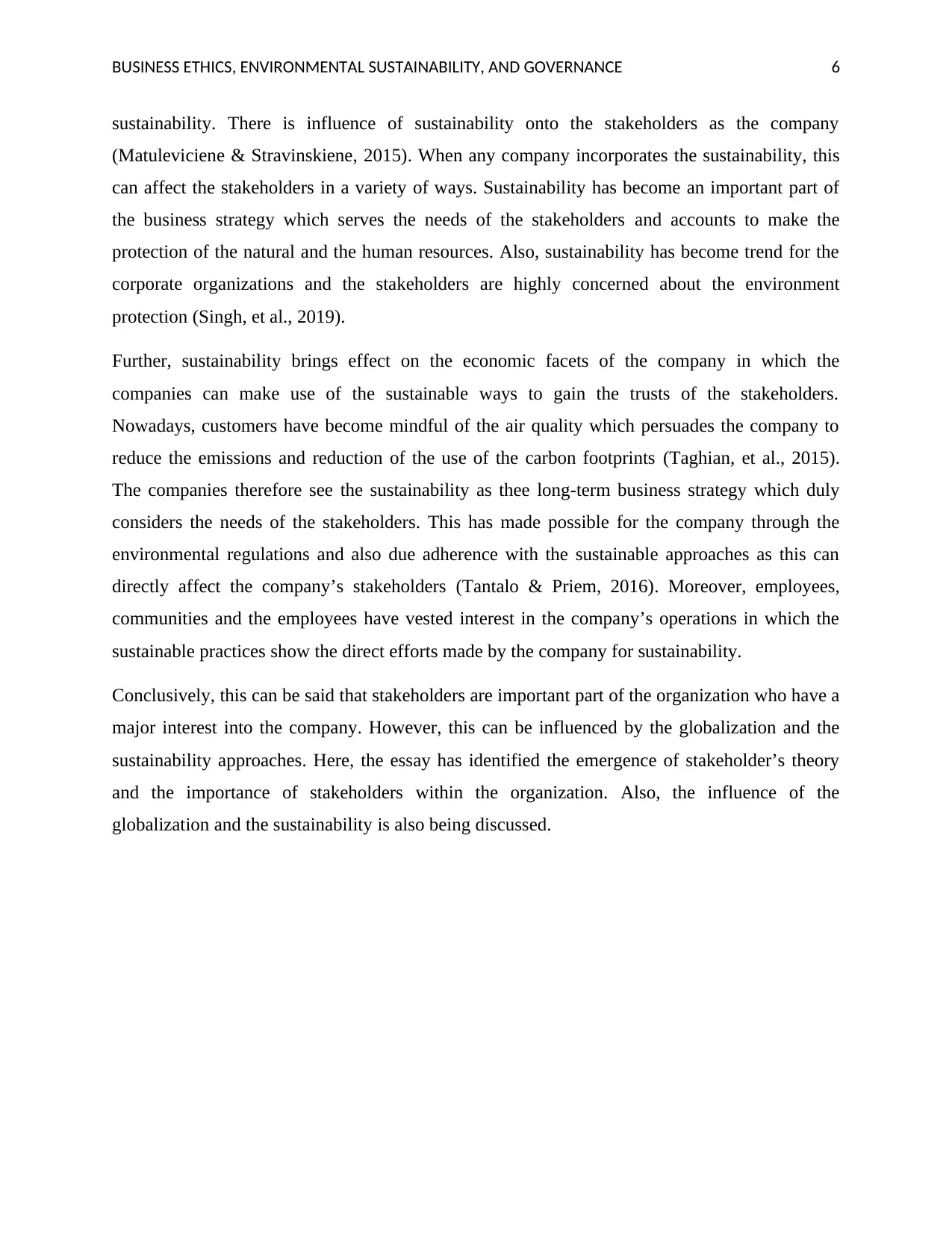
BUSINESS ETHICS, ENVIRONMENTAL SUSTAINABILITY, AND GOVERNANCE 6
sustainability. There is influence of sustainability onto the stakeholders as the company
(Matuleviciene & Stravinskiene, 2015). When any company incorporates the sustainability, this
can affect the stakeholders in a variety of ways. Sustainability has become an important part of
the business strategy which serves the needs of the stakeholders and accounts to make the
protection of the natural and the human resources. Also, sustainability has become trend for the
corporate organizations and the stakeholders are highly concerned about the environment
protection (Singh, et al., 2019).
Further, sustainability brings effect on the economic facets of the company in which the
companies can make use of the sustainable ways to gain the trusts of the stakeholders.
Nowadays, customers have become mindful of the air quality which persuades the company to
reduce the emissions and reduction of the use of the carbon footprints (Taghian, et al., 2015).
The companies therefore see the sustainability as thee long-term business strategy which duly
considers the needs of the stakeholders. This has made possible for the company through the
environmental regulations and also due adherence with the sustainable approaches as this can
directly affect the company’s stakeholders (Tantalo & Priem, 2016). Moreover, employees,
communities and the employees have vested interest in the company’s operations in which the
sustainable practices show the direct efforts made by the company for sustainability.
Conclusively, this can be said that stakeholders are important part of the organization who have a
major interest into the company. However, this can be influenced by the globalization and the
sustainability approaches. Here, the essay has identified the emergence of stakeholder’s theory
and the importance of stakeholders within the organization. Also, the influence of the
globalization and the sustainability is also being discussed.
sustainability. There is influence of sustainability onto the stakeholders as the company
(Matuleviciene & Stravinskiene, 2015). When any company incorporates the sustainability, this
can affect the stakeholders in a variety of ways. Sustainability has become an important part of
the business strategy which serves the needs of the stakeholders and accounts to make the
protection of the natural and the human resources. Also, sustainability has become trend for the
corporate organizations and the stakeholders are highly concerned about the environment
protection (Singh, et al., 2019).
Further, sustainability brings effect on the economic facets of the company in which the
companies can make use of the sustainable ways to gain the trusts of the stakeholders.
Nowadays, customers have become mindful of the air quality which persuades the company to
reduce the emissions and reduction of the use of the carbon footprints (Taghian, et al., 2015).
The companies therefore see the sustainability as thee long-term business strategy which duly
considers the needs of the stakeholders. This has made possible for the company through the
environmental regulations and also due adherence with the sustainable approaches as this can
directly affect the company’s stakeholders (Tantalo & Priem, 2016). Moreover, employees,
communities and the employees have vested interest in the company’s operations in which the
sustainable practices show the direct efforts made by the company for sustainability.
Conclusively, this can be said that stakeholders are important part of the organization who have a
major interest into the company. However, this can be influenced by the globalization and the
sustainability approaches. Here, the essay has identified the emergence of stakeholder’s theory
and the importance of stakeholders within the organization. Also, the influence of the
globalization and the sustainability is also being discussed.
Paraphrase This Document
Need a fresh take? Get an instant paraphrase of this document with our AI Paraphraser
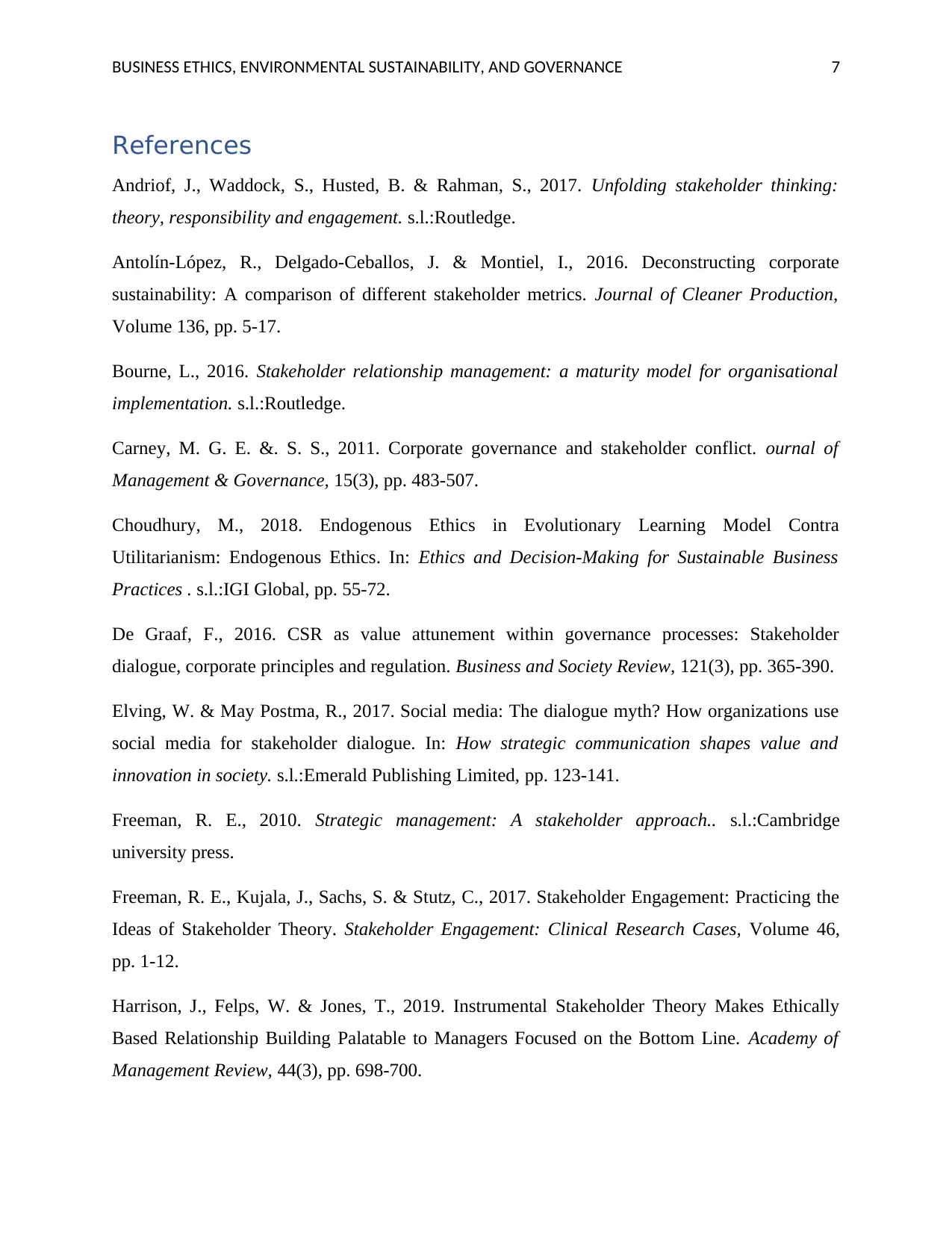
BUSINESS ETHICS, ENVIRONMENTAL SUSTAINABILITY, AND GOVERNANCE 7
References
Andriof, J., Waddock, S., Husted, B. & Rahman, S., 2017. Unfolding stakeholder thinking:
theory, responsibility and engagement. s.l.:Routledge.
Antolín-López, R., Delgado-Ceballos, J. & Montiel, I., 2016. Deconstructing corporate
sustainability: A comparison of different stakeholder metrics. Journal of Cleaner Production,
Volume 136, pp. 5-17.
Bourne, L., 2016. Stakeholder relationship management: a maturity model for organisational
implementation. s.l.:Routledge.
Carney, M. G. E. &. S. S., 2011. Corporate governance and stakeholder conflict. ournal of
Management & Governance, 15(3), pp. 483-507.
Choudhury, M., 2018. Endogenous Ethics in Evolutionary Learning Model Contra
Utilitarianism: Endogenous Ethics. In: Ethics and Decision-Making for Sustainable Business
Practices . s.l.:IGI Global, pp. 55-72.
De Graaf, F., 2016. CSR as value attunement within governance processes: Stakeholder
dialogue, corporate principles and regulation. Business and Society Review, 121(3), pp. 365-390.
Elving, W. & May Postma, R., 2017. Social media: The dialogue myth? How organizations use
social media for stakeholder dialogue. In: How strategic communication shapes value and
innovation in society. s.l.:Emerald Publishing Limited, pp. 123-141.
Freeman, R. E., 2010. Strategic management: A stakeholder approach.. s.l.:Cambridge
university press.
Freeman, R. E., Kujala, J., Sachs, S. & Stutz, C., 2017. Stakeholder Engagement: Practicing the
Ideas of Stakeholder Theory. Stakeholder Engagement: Clinical Research Cases, Volume 46,
pp. 1-12.
Harrison, J., Felps, W. & Jones, T., 2019. Instrumental Stakeholder Theory Makes Ethically
Based Relationship Building Palatable to Managers Focused on the Bottom Line. Academy of
Management Review, 44(3), pp. 698-700.
References
Andriof, J., Waddock, S., Husted, B. & Rahman, S., 2017. Unfolding stakeholder thinking:
theory, responsibility and engagement. s.l.:Routledge.
Antolín-López, R., Delgado-Ceballos, J. & Montiel, I., 2016. Deconstructing corporate
sustainability: A comparison of different stakeholder metrics. Journal of Cleaner Production,
Volume 136, pp. 5-17.
Bourne, L., 2016. Stakeholder relationship management: a maturity model for organisational
implementation. s.l.:Routledge.
Carney, M. G. E. &. S. S., 2011. Corporate governance and stakeholder conflict. ournal of
Management & Governance, 15(3), pp. 483-507.
Choudhury, M., 2018. Endogenous Ethics in Evolutionary Learning Model Contra
Utilitarianism: Endogenous Ethics. In: Ethics and Decision-Making for Sustainable Business
Practices . s.l.:IGI Global, pp. 55-72.
De Graaf, F., 2016. CSR as value attunement within governance processes: Stakeholder
dialogue, corporate principles and regulation. Business and Society Review, 121(3), pp. 365-390.
Elving, W. & May Postma, R., 2017. Social media: The dialogue myth? How organizations use
social media for stakeholder dialogue. In: How strategic communication shapes value and
innovation in society. s.l.:Emerald Publishing Limited, pp. 123-141.
Freeman, R. E., 2010. Strategic management: A stakeholder approach.. s.l.:Cambridge
university press.
Freeman, R. E., Kujala, J., Sachs, S. & Stutz, C., 2017. Stakeholder Engagement: Practicing the
Ideas of Stakeholder Theory. Stakeholder Engagement: Clinical Research Cases, Volume 46,
pp. 1-12.
Harrison, J., Felps, W. & Jones, T., 2019. Instrumental Stakeholder Theory Makes Ethically
Based Relationship Building Palatable to Managers Focused on the Bottom Line. Academy of
Management Review, 44(3), pp. 698-700.
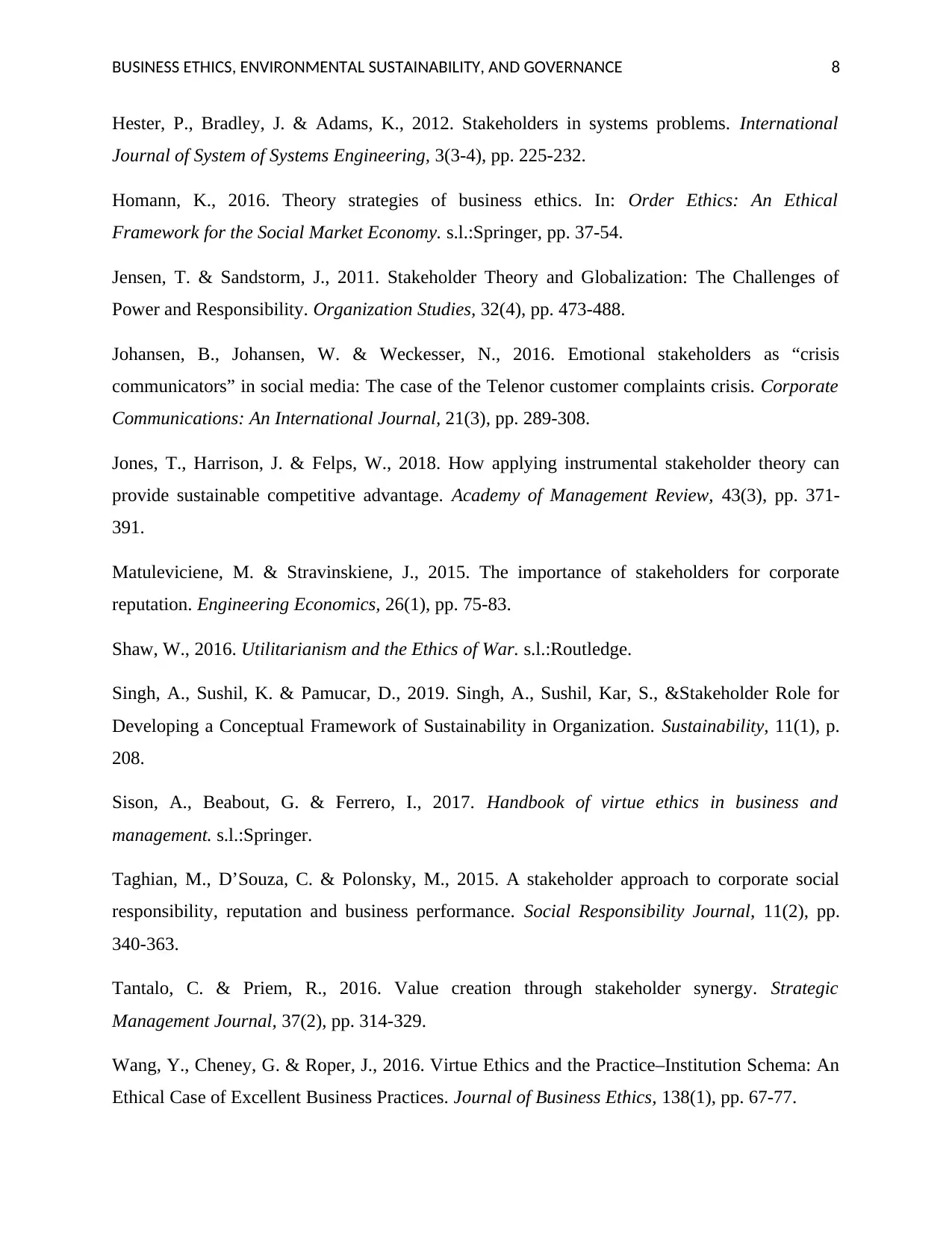
BUSINESS ETHICS, ENVIRONMENTAL SUSTAINABILITY, AND GOVERNANCE 8
Hester, P., Bradley, J. & Adams, K., 2012. Stakeholders in systems problems. International
Journal of System of Systems Engineering, 3(3-4), pp. 225-232.
Homann, K., 2016. Theory strategies of business ethics. In: Order Ethics: An Ethical
Framework for the Social Market Economy. s.l.:Springer, pp. 37-54.
Jensen, T. & Sandstorm, J., 2011. Stakeholder Theory and Globalization: The Challenges of
Power and Responsibility. Organization Studies, 32(4), pp. 473-488.
Johansen, B., Johansen, W. & Weckesser, N., 2016. Emotional stakeholders as “crisis
communicators” in social media: The case of the Telenor customer complaints crisis. Corporate
Communications: An International Journal, 21(3), pp. 289-308.
Jones, T., Harrison, J. & Felps, W., 2018. How applying instrumental stakeholder theory can
provide sustainable competitive advantage. Academy of Management Review, 43(3), pp. 371-
391.
Matuleviciene, M. & Stravinskiene, J., 2015. The importance of stakeholders for corporate
reputation. Engineering Economics, 26(1), pp. 75-83.
Shaw, W., 2016. Utilitarianism and the Ethics of War. s.l.:Routledge.
Singh, A., Sushil, K. & Pamucar, D., 2019. Singh, A., Sushil, Kar, S., &Stakeholder Role for
Developing a Conceptual Framework of Sustainability in Organization. Sustainability, 11(1), p.
208.
Sison, A., Beabout, G. & Ferrero, I., 2017. Handbook of virtue ethics in business and
management. s.l.:Springer.
Taghian, M., D’Souza, C. & Polonsky, M., 2015. A stakeholder approach to corporate social
responsibility, reputation and business performance. Social Responsibility Journal, 11(2), pp.
340-363.
Tantalo, C. & Priem, R., 2016. Value creation through stakeholder synergy. Strategic
Management Journal, 37(2), pp. 314-329.
Wang, Y., Cheney, G. & Roper, J., 2016. Virtue Ethics and the Practice–Institution Schema: An
Ethical Case of Excellent Business Practices. Journal of Business Ethics, 138(1), pp. 67-77.
Hester, P., Bradley, J. & Adams, K., 2012. Stakeholders in systems problems. International
Journal of System of Systems Engineering, 3(3-4), pp. 225-232.
Homann, K., 2016. Theory strategies of business ethics. In: Order Ethics: An Ethical
Framework for the Social Market Economy. s.l.:Springer, pp. 37-54.
Jensen, T. & Sandstorm, J., 2011. Stakeholder Theory and Globalization: The Challenges of
Power and Responsibility. Organization Studies, 32(4), pp. 473-488.
Johansen, B., Johansen, W. & Weckesser, N., 2016. Emotional stakeholders as “crisis
communicators” in social media: The case of the Telenor customer complaints crisis. Corporate
Communications: An International Journal, 21(3), pp. 289-308.
Jones, T., Harrison, J. & Felps, W., 2018. How applying instrumental stakeholder theory can
provide sustainable competitive advantage. Academy of Management Review, 43(3), pp. 371-
391.
Matuleviciene, M. & Stravinskiene, J., 2015. The importance of stakeholders for corporate
reputation. Engineering Economics, 26(1), pp. 75-83.
Shaw, W., 2016. Utilitarianism and the Ethics of War. s.l.:Routledge.
Singh, A., Sushil, K. & Pamucar, D., 2019. Singh, A., Sushil, Kar, S., &Stakeholder Role for
Developing a Conceptual Framework of Sustainability in Organization. Sustainability, 11(1), p.
208.
Sison, A., Beabout, G. & Ferrero, I., 2017. Handbook of virtue ethics in business and
management. s.l.:Springer.
Taghian, M., D’Souza, C. & Polonsky, M., 2015. A stakeholder approach to corporate social
responsibility, reputation and business performance. Social Responsibility Journal, 11(2), pp.
340-363.
Tantalo, C. & Priem, R., 2016. Value creation through stakeholder synergy. Strategic
Management Journal, 37(2), pp. 314-329.
Wang, Y., Cheney, G. & Roper, J., 2016. Virtue Ethics and the Practice–Institution Schema: An
Ethical Case of Excellent Business Practices. Journal of Business Ethics, 138(1), pp. 67-77.
⊘ This is a preview!⊘
Do you want full access?
Subscribe today to unlock all pages.

Trusted by 1+ million students worldwide
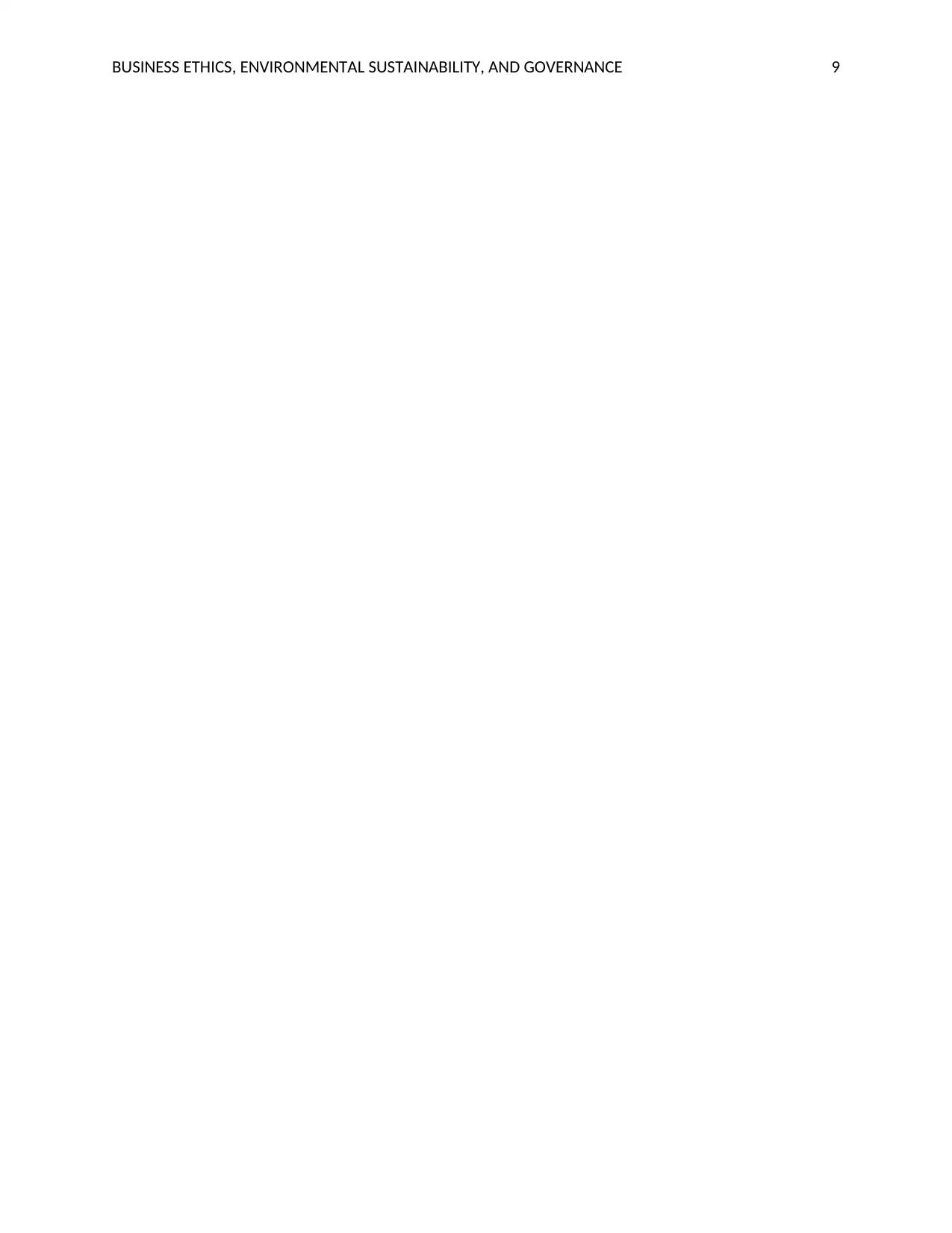
BUSINESS ETHICS, ENVIRONMENTAL SUSTAINABILITY, AND GOVERNANCE 9
1 out of 10
Related Documents
Your All-in-One AI-Powered Toolkit for Academic Success.
+13062052269
info@desklib.com
Available 24*7 on WhatsApp / Email
![[object Object]](/_next/static/media/star-bottom.7253800d.svg)
Unlock your academic potential
Copyright © 2020–2025 A2Z Services. All Rights Reserved. Developed and managed by ZUCOL.




